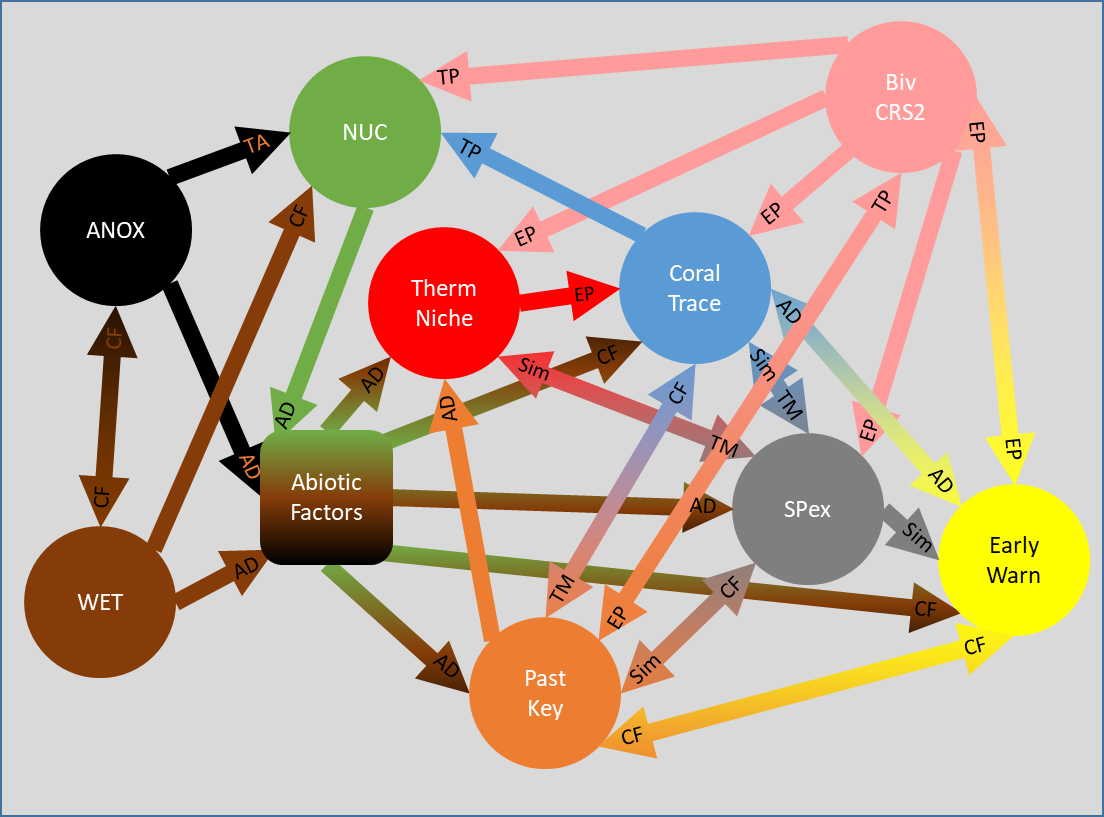Topics in initial phase
Magmatic processes
 In terms of magmatic processes we have experience in the geology and geochronology of continental flood basalts and other large
igneous provinces (Regelous et al. 2003, Turner et al. 1994), and in the physical and environmental consequences of volcanism
(Brandl et al. 2013). Our working group also has experience with developing new techniques in mass spectrometry (Regelous et al. 2008,
Regelous et al. 2004), which will be critical for accurate measurement of trace element proxies of volcanism in sediments such as Hg, Bi,
Sb, Se, Re. As these elements are present at the ng/g level they are difficult to measure using conventional methods.
In terms of magmatic processes we have experience in the geology and geochronology of continental flood basalts and other large
igneous provinces (Regelous et al. 2003, Turner et al. 1994), and in the physical and environmental consequences of volcanism
(Brandl et al. 2013). Our working group also has experience with developing new techniques in mass spectrometry (Regelous et al. 2008,
Regelous et al. 2004), which will be critical for accurate measurement of trace element proxies of volcanism in sediments such as Hg, Bi,
Sb, Se, Re. As these elements are present at the ng/g level they are difficult to measure using conventional methods.
Paleobiological data
We also have a profound track record on the ecological patterns, evolutionary consequences and selectivity of mass extinctions, both at Phanerozoic scale (Kiessling et al. 2008, Kiessling and Simpson 2011) and in specific events (Aberhan and Baumiller 2003, Aberhan et al. 2007, Kiessling et al. 2007, Kiessling and Baron-Szabo 2004, Kiessling and Danelian 2011). These studies are directly relevant to one or more factors of the deadly trio. Importantly estimates of diversity and extinction rates are assessed with the most current methods of sampling standardization and counting, which are required to avoid classical pitfalls such as the Signor-Lipps Effect. In addition to the impact of extinction on taxic patterns we also assessed the effect of extinctions on morphological patterns (Villier and Korn 2004) defining an extinction space (Korn et al. 2013). Body size trends in Paleozoic invertebrates and their link to environmental changes were recently assessed (Klug et al. 2015). We are also involved in assessing the biotic consequences of current climate change using meta-analyses (Poloczanska et al. 2013, Pörtner et al. 2014, Storch et al. 2014, Wittmann and Pörtner 2013) and animal physiology. Physiological work on marine animals led us to propose the concept of oxygen and capacity limited thermal tolerance (OCLTT). This concept integrates molecular to ecosystem levels of biological organisation and the interaction of the various temperature-related stresses in terms of dynamic changes in thermal sensitivity (Pörtner 2010, Pörtner 2012). Earlier considerations of these interactions in a climate change context already led to insights how and via which physiological mechanisms present climate variability and climate oscillations in Earth history may have benefited eurythermal life forms and associated lifestyles (Pörtner et al. 2005). Kiessling, the spokesperson of this RU, has long worked on biodiversity patterns, mass extinctions and reef crises and has been involved in several international research groups focusing on deep and shallow time patterns on sources and sinks in biodiversity and impacts of climate change. He was already involved in a Research Training Group (GRK 503, mass extinctions) and a Research Unit (FOR 736, Cambrian explosion) and led a Project Bundle on Evolutionary Rates (PAK 602). Therefore, he has the required experience to lead TERSANE. Kiessling is also regularly contacted by the media (online services, newspapers, radio stations, TV) on ecological consequences of climate change and mass extinctions, which will facilitate outreach during the course of this project.
Proxy data
Our group has an excellent track record in applying geochemical proxy data to identify perturbations of the earth system. New tools for paleotemperature estimates (oxygen isotopes from conodont apatite) have been developed by one our group and used to identify climate changes associated with major mass extinctions (e.g. Buggisch et al. 2010, Joachimski and Buggisch 2002, Joachimski et al. 2012, Schobben et al. 2014, Sun et al. 2012). We published the first boron isotope (d11B) values for Silurian to Permian brachiopod calcite to reconstruct Paleozoic seawater pH (Joachimski et al. 2005), identified distinct ocean pH conditions and variations in ocean-atmosphere CO2 exchange for the Cryogenium based on d11B in marine carbonates (Kasemann et al. 2005, Kasemann et al. 2010) (Kasemann et al. 2005, Kasemann et al. 2010), and found evidence for ocean acidification in the second pulse of the Permian-Triassic mass extinction (Clarkson et al. 2015). Carbon-cycle perturbations of ancient bioevents have been explored using stable carbon and sulfur isotopes (Joachimski 1997, Joachimski et al. 2001). Our preliminary compilation of past temperature changes measured over six orders of timespans has demonstrated that rate estimates are highly dependent on timespan and resolution of observations and follow a power law (Kemp et al., Kiessling and Eichenseer, 2015).